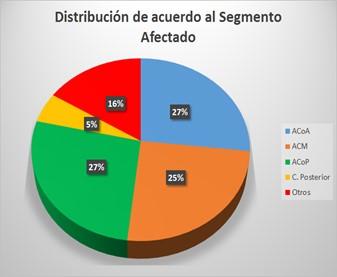Usted está aquí
Peruvian Journal of Neurosurgery
Definitive treatment of cerebral aneurysms at the Cayetano Heredia National Hospital in Lima Peru: a case series results.
ABSTRACT
Objectives: Subarachnoid hemorrhage (SAH) due to rupture of a cerebral aneurysm continues to be a disease with high morbidity and mortality in our setting, despite advances in microsurgery and endovascular therapy. The objective of the present study was to determine the demography, vascular territory, and complications that occur in the perioperative management of patients with ruptured cerebral aneurysms treated at the Cayetano Heredia Hospital.
Methods: An observational descriptive study of patients with cerebral aneurysm undergoing surgical and endovascular treatment was carried out in the Neurosurgery Service of the Cayetano Heredia Hospital from 2016 to 2018. The clinical records and operative reports were reviewed.
Results: In a period of 30 months, definitive treatment was performed in 56 patients with a diagnosis of a ruptured cerebral aneurysm, of which 5 received endovascular treatment and 51 treatment by craniotomy and clipping. 62.5% were women, and 50% of the total were between the fifth and sixth decade of life. In more than 50% of cases, treatment was performed within 96 hours of SAH. Regarding the affected arterial territory, 15 patients (27%) had an aneurysm of the territory of the anterior communicating (AComA) and another 15 (27%) in the posterior communicating artery (PComA). Mortality was 17.8%, 70% being due to direct causes such as cerebral infarction and severe vasospasm.
Conclusions: The treatment of the aneurysms was mainly by microsurgery, the aneurysms of the AComA, PComA, and middle cerebral (MCA) had a similar proportion and, in more than 50% the treatment was carried out in the first 4 days. More state support is required to increase endovascular therapy and obtain more promising results.
Keywords: Intracranial Aneurysm, Microsurgery, Craniotomy, Endovascular Procedures (source: MeSH NLM)



